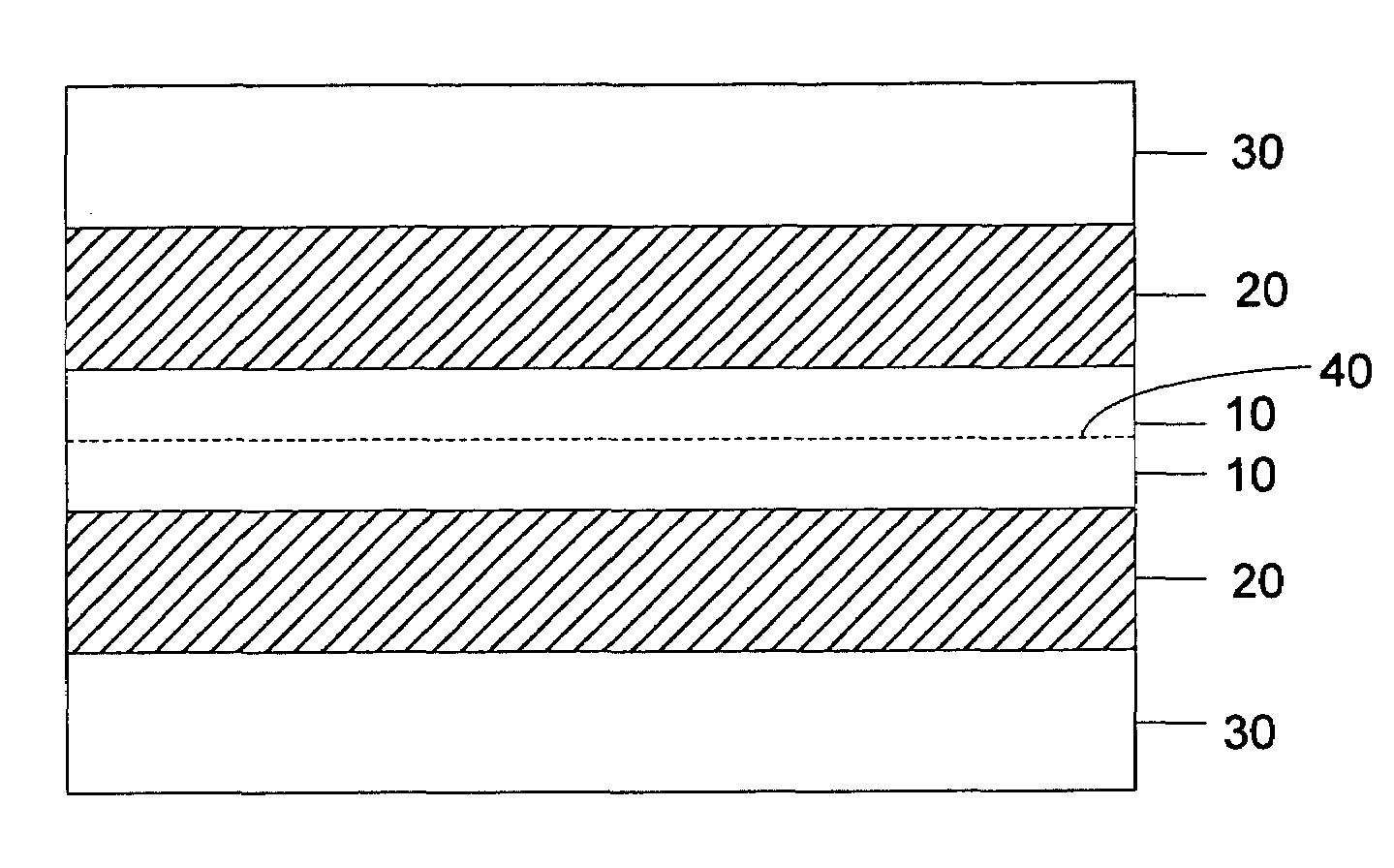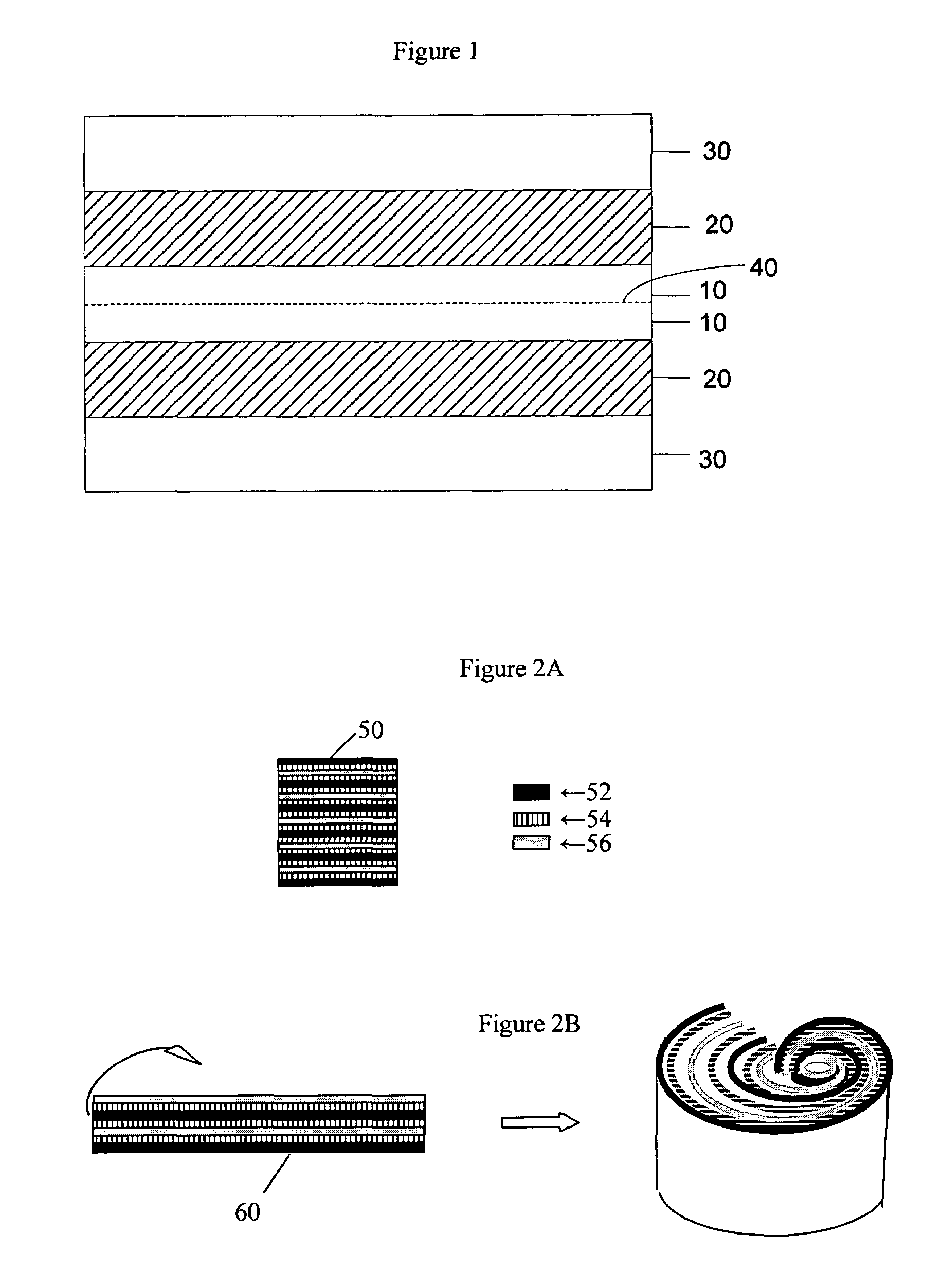Supercapacitor having electrode material comprising single-wall carbon nanotubes and process for making the same
a carbon nanotube and supercapacitor technology, applied in the direction of electrolytic capacitors, multiple hybrid/edl capacitors, nano-informatics, etc., can solve the problems of low energy storage capacity, limited power density and the number of charging cycles, and suitable metal oxides
- Summary
- Abstract
- Description
- Claims
- Application Information
AI Technical Summary
Benefits of technology
Problems solved by technology
Method used
Image
Examples
example 1
[0095]This example demonstrates a method for preparing a composite film comprising single-wall carbon nanotubes and 90 / 10 poly(acrylonitrile / methyl acrylate) copolymer “P(AN / MA).” The composite is designated SWNT-P(AN / MA).
[0096]75 mg powdered 90 / 10 poly(acrylonitrile / methyl acrylate) copolymer, Mol. Wt.≈100,000 g / mol, (obtained from Aldrich) was added to 50 mls dimethylformamide (DMF) and stirred with a magnetic stirrer at room temperature for 24 hours to form a homogeneous P(AN / MA) / DMF solution. Single-wall carbon nanotubes (Lot No. HIPCO86) were obtained from Rice University, where they were made in a high temperature, high pressure, all-gas phase process through the disproportionation of carbon monoxide (CO) to SWNT and CO2 using iron as the transition metal catalyst. A suspension of SWNT was prepared by adding 50 mg unpurified, as-produced SWNT to the P(AN / MA) / DMF solution and homogenizing with a Bio-Homogenizer (Model 133 / 1281-0, Biospec Products Inc., Bartlesville, Okla.) for ...
example 2
[0097]This example demonstrates the heat treatment of SWNT-P(AN / MA) composite film samples. SWNT-P(AN / MA) composite film samples in the shape of 11.82-mm diameter round pieces were subjected to various heat treatments in the presence of different gaseous environments. Each heat treatment was conducted by placing the SWNT-P(AN / MA) composite film sample in a tubular furnace heated to a particular temperature and holding the sample at that temperature for a period of time in the presence of a particular gaseous environment. One sample, designated as a control film, was not subjected to any post-treatment in order to determine the effect of the treatments. The samples and heat treatments are listed in Table I.
[0098]
TABLE IHeat-treatmentHeatTemperaturetreatment timeHeat treatmentSample Designation(° C.)(minutes)environmentSWNT-P(AN / MA)No heatNoneNot applicableControl filmtreatmentAir-25025010airAr-4004003argonAr-7007003argonAr-270030argonAr-10001000 3argon
example 3
[0099]This example shows the microstructure of the heat-treated SWNT-P(AN / MA) film sample. Scanning electron micrographs (SEM) were taken of as-received single-wall carbon nanotubes (Rice University Lot HIPCO86) and the heat treated SWNT-P(AN / MA) films prepared in Example 2. FIG. 3 shows a SEM photomicrograph of the as-received single-wall carbon nanotubes. In this micrograph, the single-wall carbon nanotubes appear as a mat of tangled bundles of substantially-aligned SWNT called ropes. The diameters of the SWNT ropes in this example ranged from about 28 nm to about 42 nm.
[0100]A SEM micrograph of the SWNT-P(AN / MA) film sample heated at 700° C. for 3 minutes in argon (designated Ar-700), given in FIG. 4, shows a mat of tangled SWNT rope-like structures, similar to the as-received SWNT, but, in this case, encapsulated in P(AN / MA). The diameters of the SWNT-P(AN / MA) composite ropes in this example ranged from about 49 nm to about 65 nm. SEMs of the other heat-treated SWNT-P(AN / MA) com...
PUM
| Property | Measurement | Unit |
|---|---|---|
| weight ratio | aaaaa | aaaaa |
| voltage | aaaaa | aaaaa |
| temperature | aaaaa | aaaaa |
Abstract
Description
Claims
Application Information
 Login to View More
Login to View More - R&D
- Intellectual Property
- Life Sciences
- Materials
- Tech Scout
- Unparalleled Data Quality
- Higher Quality Content
- 60% Fewer Hallucinations
Browse by: Latest US Patents, China's latest patents, Technical Efficacy Thesaurus, Application Domain, Technology Topic, Popular Technical Reports.
© 2025 PatSnap. All rights reserved.Legal|Privacy policy|Modern Slavery Act Transparency Statement|Sitemap|About US| Contact US: help@patsnap.com



